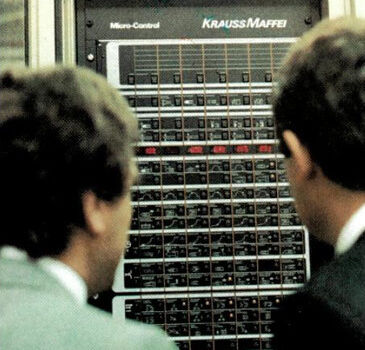
Trendgineering
Lightweight and rust-proof: Leaf springs made of composites
| Petra Rehmet
Interview with Philipp Zimmermann and Tobias Fürst
They save space, reduce weight and cannot corrode, even if a lot of salt is present. Leaf springs made of fiber-reinforced plastics are taking over the automotive industry. Philipp Zimmermann, Head of the Composites/Surfaces BU at KraussMaffei, and Tobias Fürst, Executive Vice President at Schmidt & Heinzmann, explain the manufacturing processes and advantages.
ahead:
When comparing a leaf spring made of composites to the steel design, what are the most significant differences?
Zimmermann:
The most striking difference is the weight difference. On our demonstrator from K 2019, which is based on the geometry of a middle-class sedan, this component weighs just 2.2 kilograms. A similar variant made of steel weighs almost twice as much.
Fürst:
The weight reduction is even more significant in heavy trucks in which leaf springs are used most frequently. One example from DEKRA compares a steel spring package with approximately 70 kg to a composite design with a component weight of just 35 kg. According to DEKRA, there is a potential of almost 400 kilograms if there are five axles and a total of ten springs. This is unassigned weight, which is either available for an additional load or reduces fuel consumption.
ahead:
How do I need to visualize this type of leaf spring?
Zimmermann:
Any type of defect is capable of causing elastic deformation and, as a result, energy absorption. For leaf springs, this occurs through individual layers that are arranged on top of each other and stretch with increasing length to the wheel, which results in elasticity in the composite material. The frequency of the leaf springs determines the performance, which spans from sporty to comfortable. Leaf springs are extremely durable and are being used more and more in the SUV/van business area. Leaf springs made of composites enable completely new chassis designs here.

Interview with:
Philipp Zimmermann, Head BU Composites/Surfaces KraussMaffei
ahead:
Is it easy to manufacture this type of spring made of composites?
Fürst:
It starts with the so-called multi-preform, which is produced from specifically tailored individual layers of a fiberglass textile that are stacked on each other. The stack is formed in accordance with the desired geometry and its contours are hardened in a heated mold. Ultrasound can be used to cut the individual leaf spring preforms, which are always just a few centimeters wide, from the multi-preform. Ideally, this multi-preform will be the same width as the semi-finished fiber product that is used.
Zimmermann:
Then, these are put into a mold carrier (molding press), where they are infiltrated with the epoxy resin matrix material and then molded into the desired shape. This is done using pressure levels of up to 90 bar, which is why this technology bears the name high-pressure resin transfer molding (HP-RTM). The metering system and the mold carrier form the most important system components for manufacturing leaf springs. KraussMaffei is the leader here in all areas, with over 100 machines in the market and the largest pool of process-related expertise. This is followed by post-mold processing through milling, a process in which protruding material is removed.
"Leaf springs made of composites are up to 60 percent lighter than the previous product made of steel. Its strength can be deliberately increased in sections where it is required and the corrosion resistance offers further added value."Philipp Zimmermann, Head BU Composites/Surfaces KraussMaffei
ahead:
You rely on glass fibers as fiber reinforcement for the demonstrator. Why is that?
Fürst:
Glass-fiber reinforced plastics (GFRP) have proven to be the ideal material for leaf springs because they combine excellent damping properties with a high level of mechanical strength and corrosion resistance. Furthermore, there is an economic aspect. Glass-fiber reinforced plastics are substantially more cost-effective than carbon-fiber reinforced plastics (CFRP).

Presented the composites leaf spring at the K-show 2019:
Philipp Zimmermann, moderator Thomas Sauermann and Tobias Fürst (from letft to right)
ahead:
In addition to the weight and corrosion resistance, are there other advantages to leaf springs made of composites?
Fürst:
In terms of processes, we are very flexible when it comes to changed geometries or designs, which is an important criterion with respect to the wealth of variants in vehicle manufacturing. The molding press requires just one new mold and you can manufacture the other variant immediately. Even sensors and additional functions can be integrated without a great deal of effort. Of course, a lightweight spring is much easier to install than a heavy spring.
Zimmermann:
Thanks to the design of the preform, you can reinforce the GFRP springs in the precise areas where there are high levels of force. As a result, the springs require up to 75 percent less space than the steel variants overall. This is mainly of interest with respect to electromobility, in which there should be as much storage space for batteries as possible. Here, we see great growth potential for all lightweight construction technologies.
"In terms of processes, leaf springs made of composites are very flexible when it comes to changed geometries or designs, which is an important criterion with respect to the wealth of variants in vehicle manufacturing."Tobias Fürst, Executive Vice President Schmidt und Heinzmann
ahead:
KraussMaffei has coordinated a large number of partners for the leaf spring project. How does it work, and how does someone come up with the idea to do something like this?
Zimmermann:
We wanted to show HRC, a customer of ours, what is possible. Collaboration with all participants is going very smoothly. KraussMaffei took on the project management function, which allowed each specialist to focus on their own area, such as the design of the component (Engenuity), production of the matrix (Huntsman), fiber roving (Johns Manville), the preforms (Schmidt & Heinzmann) or the mold (Alpex) and post-mold processing (Hufschmied). In keeping with the idea of "one face to the customer," HRC had just one contact. We would like to sincerely thank our partners for the effective, professional collaboration we have had with them.

Teamwork is the key to success
KraussMaffei and its partners at K 2019
Contact
philipp.zimmermann@kraussmaffei.com















